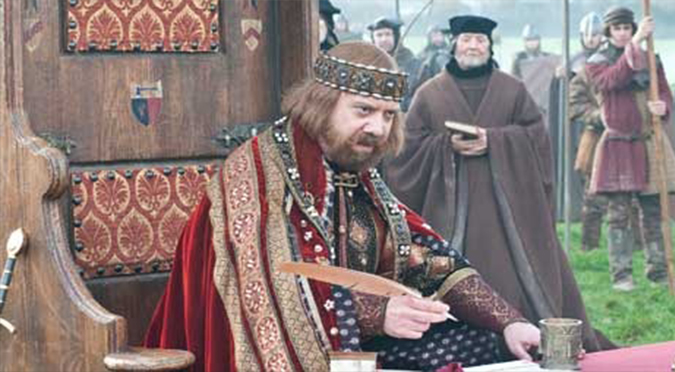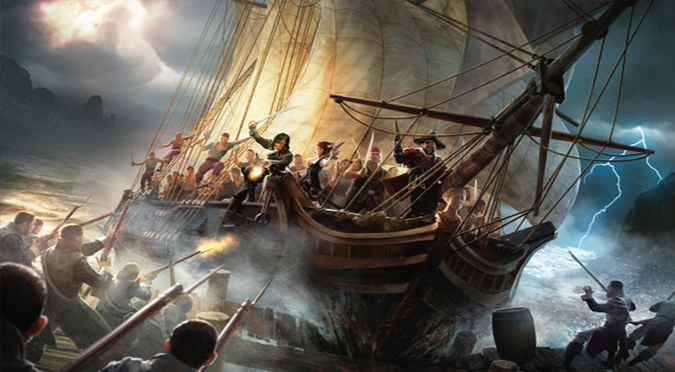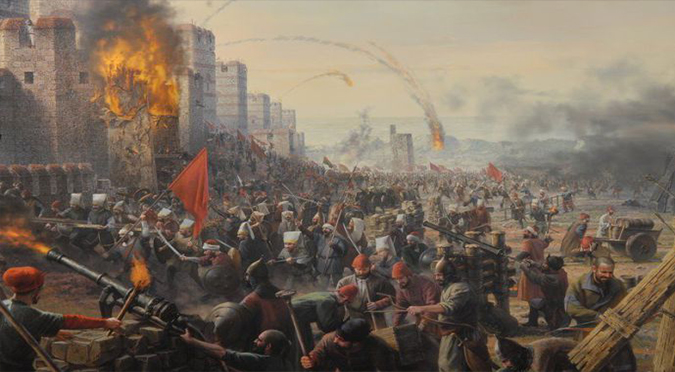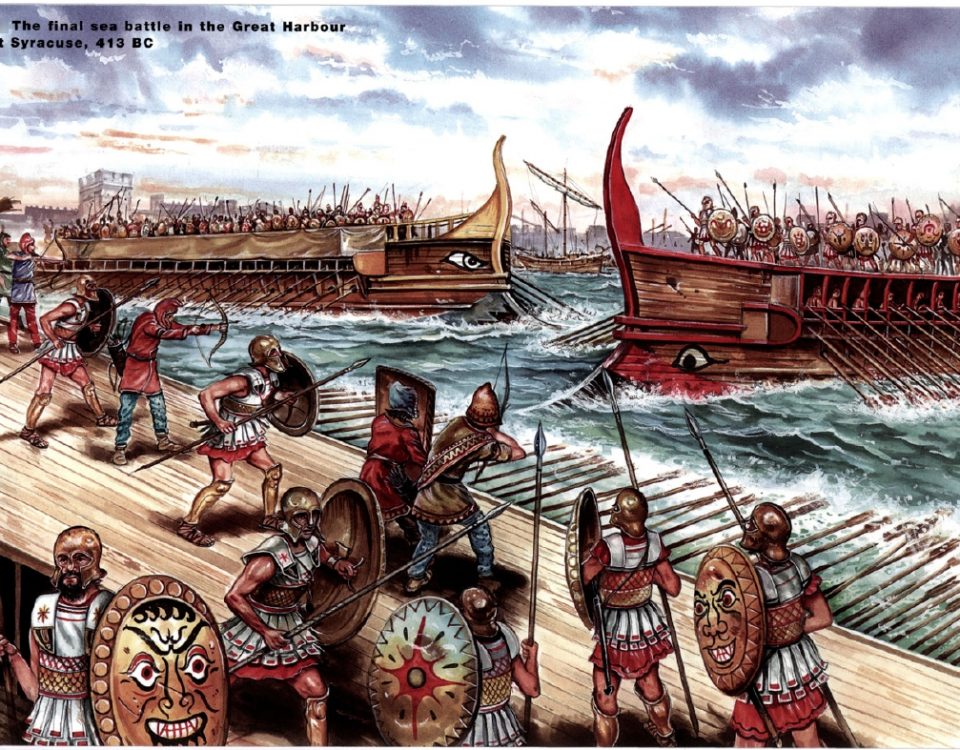
KING JOHN vs THE MAGNA CARTA
August 21, 2014
THE GOLDEN AGE OF PIRACY (Part One)
September 19, 2014The Fall of Constantinople 1453
For over a thousand years, Constantinople stood as the center of the known world, a crossroads between ‘East’ and ‘West’. This ancient city was a prized jewel for all manner of conquerors. The great city was an indestructible fortress with +100 defense. Like an underdog turned undefeated champion on a winning streak, Constantinople miraculously withstood wave after wave of attack: the Huns, the Mongols, the Persians, the Seljuks, you name it… well, that is until the year 1453 rolled around and the entire kingdom fell like a house of cards thanks to one dumb @#$ who left the gate open, but I’m getting ahead of myself.

BYZANTIUM
Way (way) back in 657 BCE, Byzantium was founded by the Ancient Greeks. Several hundred years later it was conquered by the Roman Empire (you know those pompous toga-wearing guys with an affinity for vomitoriums). Then one day, in 324 CE, Emperor Constantine was bored so decided to rename Byzantium after himself. Constantine established ‘Constantinople’ as the brand spankin’ new capitol of the now ‘Holy’ Roman Empire. This turned out to be a VERY bad move, seeing as Constantinople was on the outskirts of the Empire, whereas Rome was dead center, making it very hard to manage. This didn’t last long, because it was a stupid idea to begin with.
 The New and Improved Byzantine Empire expanded throughout the East under Emperors Theodosius and Justinian. During the 8th and 9th centuries, religious icons were banned by both Leo III and Constantine V, leading to the destruction of dozens of works of art ironically deemed sacrilege. This would ultimately become one of the main factors of division between the East and West Roman Empires, eventually leading to THE GREAT SCHISM of 1054 when Pope Leo IX excommunicated the Orthodox Church of Constantinople over petty differences in Christian belief and practice, like whether or not to use leavened or unleavened bread during mass.
The New and Improved Byzantine Empire expanded throughout the East under Emperors Theodosius and Justinian. During the 8th and 9th centuries, religious icons were banned by both Leo III and Constantine V, leading to the destruction of dozens of works of art ironically deemed sacrilege. This would ultimately become one of the main factors of division between the East and West Roman Empires, eventually leading to THE GREAT SCHISM of 1054 when Pope Leo IX excommunicated the Orthodox Church of Constantinople over petty differences in Christian belief and practice, like whether or not to use leavened or unleavened bread during mass.
In 1202, Pope Innocent III called for a Fourth Crusade to take Jerusalem ‘back’ from the Muslims and maybe conquer Egypt while they were at it (at the time there was a truce, but they just wanted the Holy Land all to themselves). Somewhere along the way the Crusaders were diverted to Constantinople, leading to one of the most ironic twists in history: Without warning, the Christian Crusaders attacked the Christian City of Constantinople.

And so the Christian crusaders on a mission to free Jerusalem, instead ransacked the greatest Christian city the world would ever see. The Crusaders attacked shouting “Holy Sepulcher!” which roughly translates to: “The Tomb in which Jesus Christ, our Lord and Savior was buried and then resurrected on the third day!!!” The defending Greeks of Constantinople responded with their own battle cry, “Jesus Christ conquers! Hoorah!!!” (*paraphrased)
The defenders of Constantinople were completely caught off guard by this unexpected friendly fire and fell prey to three days of pillaging. Sacred relics were smashed, priceless art was destroyed and the city’s most precious treasures were looted by the greedy mercenaries. The Byzantines later reconquered their city from the Latin Empire in 1261, but now that they were surrounded by enemies, with their previous wealth depleted, Constantinople would never again be the same…
RISE OF THE OTTOMAN EMPIRE

No… not those ones…
Two factions of the Islamic faith, the Sunni and the Shi’a have been at war since the days after Muhammad when the Muslims became divided into warring tribes. In the midst of this never-ending conflict, during the 13th Century, Estugral, Khan of the Kayi Tribe (of the Sunni Oguz Turks), fled from the Mongol hordes of Persia and raised a Gazi force under the Sultan of Rum. His son, Osman I, founded the Osmanli dynasty which has since come to be known as the Ottoman Empire, a powerful nation that ruled for over 600 years (until World War I, but that’s a whole other story).
The Ottomans quickly took out the short-lived Serbian Empire and made the Balkans their b!%$#*. Then the Ottoman Turks spread throughout the Middle East, absorbing other cultures as their own, but they lacked a central capitol in which to rule from. Enter: Mehmed II – the young Ottoman Sultan who set his sights on the once great city of Constantinople.
“Only one thing I want: give me Constantinople!” – Mehmed the Conqueror
Mehmed II v Constantine XI

Mehmed the Conqueror’s Dating Profile Pic
The Byzantine Emperor, Constantine XI (yes, the eleventh! – they weren’t very original in the baby naming department back then), attempted to placate the young Sultan to no avail. Mehmed began by cutting off Constantinople’s supply lines from Venice, claiming that Constantine had broken the truce between their people with little to no evidence, just a shoddy excuse for war.
Before attacking, Mehmed issued Constantine an ultimatum, “I will as the law commands there, you the citizens of this greatest city, harm neither your families nor your belongings, if you voluntarily surrender the city to me.”
Constantine responded with, “To surrender the city to you is beyond my authority or anyone else’s who lives in it, for all of us, after taking the mutual decision, shall die out of free will without sparing our lives.”
Constantine ignored the threat, confident that this attempted siege would fail just like all those that came before them, but Mehmed brought something new to the table that changed everything: gunpowder!
The Ottomans forged sixty cannons and assembled 100,000 troops to take down the Capitol of the Byzantium Empire.
The Siege Begins!
On April 6th, 1453, the grand army of Turks rolled in and swarmed around the tightly defended perimeter of the city. The war drums were soon followed by a relentless succession of cannon balls blasting into the stone walls. As Turkish soldiers attempted to scale the walls they were met with both arrows to the face and boiling hot oil. They immediately focused all their firepower on one specific segment of the fortress in an attempt to burrow through.
“The explosion made all the walls of the city shake, and all the ground inside, and even the ships in the harbor felt the vibrations of it. Because of the great noise, many women fainted…” – Nicolo Barbaro
While both sides exchanged volleys of arrows, Mehmed’s navy went around the back. Although Constantine’s men had cleverly blocked off the entrance to the harbor, the Turkish ships went the long way: over land. Sicilian ships were sent in as reinforcements and attacked with their secret weapon: Greek Fire!

Pictured: A Medieval Flame Thrower
Greek Fire was a viscous flammable mixture, a mysterious substance that burns on water, originally developed by Athenian Alchemists, and later discovered by the Byzantines from the library of Alexandria. It proved to be rather effective against enemy ships. Meanwhile, the siege dragged on for FIFTY freakin’ DAYS!

The struggle is real…
Two months later…
Things were starting to look hopeless, for both sides.
Between a freak hailstorm and an eclipse, the defenders of Constantinople began to get superstitious of the ominous symbolism.
 The Turks weren’t having much luck bombarding the heavily fortified walls of the city, but as the days went on, the citizens of Constantinople began to run low on supplies. Mehmed (like Wily Coyote) was ever persistent and had several back up plans to boot. Seeing as their initial plot to tear down the walls wasn’t working, they decided to dig under them. When that didn’t work, they starting work on a massive wooden tower to go over the wall.
The Turks weren’t having much luck bombarding the heavily fortified walls of the city, but as the days went on, the citizens of Constantinople began to run low on supplies. Mehmed (like Wily Coyote) was ever persistent and had several back up plans to boot. Seeing as their initial plot to tear down the walls wasn’t working, they decided to dig under them. When that didn’t work, they starting work on a massive wooden tower to go over the wall.
The Ottomans constructed it overnight and began work on a make-shift bridge over the moat to wheel the siege tower in place. That night, some of the city’s defenders snuck out and lit a powder keg at the bottom of the tower. The rickety tower was engulfed in flame and collapsed faster than a lopsided game of Jenga, taking dozens of Turks with it.

Mehmed’s men were very close to giving up and calling it a day, but then on May 29, 1453 – someone made one very dumb mistake: a single unguarded gate was carelessly left open!
As the Ottomans made one last attempt to scale the walls of the city, and the exhausted defenders beat them back for four hours straight, one of the Turks saw that the gate was slightly ajar. He presumably did a double take, before letting his buddies in on it. It didn’t take long for fifty Ottomans to flood through the entrance. The defenders of Constantinople were overwhelmed, many of them dropped their weapons and ran from their posts, screaming for their mothers, with a steady stream of urine trailing behind.
“The blood flowed in the city like rainwater in the gutters after a sudden storm, and the corpses of Turks and Christians were thrown in the Dardanelles, where they floated out to sea like melons along a canal.” – Barbaro
As the sun rose that morning, the Ottoman banner was raised in victory. 30,000 captured – 4,000 killed.
Once the walls had been breached, the game was over.

Like running out of quarters while going for the world record…
Constantinople becomes Istanbul
Constantine’s last recorded words were: “The city is fallen and I am still alive!” He then, presumably ripped off his imperial garments, grabbed a sword, and alongside his soldiers charged into the mass of incoming Turks.

Mehmed: 1 Constantine: 0
The Sultan rode into the conquered city on a white horse, dismounted in front of the Hagia Sophia Church, one of the most astonishing building’s ever constructed. Mehmed kneeled down and poured dirt over his turban as a sign of humility. When he entered the sacred sanctuary, he saw his men chipping away at the beautiful Christian iconography and immediately ordered them to stop. The Hagia Sophia was to be preserved and transformed into the Aya Sofya mosque.
The Pope didn’t even find out about the city’s defeat until a month later! When Pope Nicholas V called for a Tenth Crusade to take back Constantinople, the response was ‘meh’ at best. You see, England and France were still licking their wounds from beating each other half to death during The Hundred Years War, the German Emperor, Frederick III, was broke, Hungary was in disarray, and King Alfonso of Spain had enough of his own problems maintaining his own territory. The Ottomans saw this as a good opportunity to wipe out what remained of the Byzantine Empire, so they did.
Meanwhile the city prospered under Mehmed’s rule, as the new capital of the Ottoman Empire, Istanbul. Christians and Jews were allowed to keep their religions and were protected as long as they paid their taxes. The Jewish community in particular had far fewer restrictions under the Ottoman Empire than they did throughout Western Europe.
Interesting side note: under the Ottoman Empire, the city of Istanbul became renowned for having more than 1,400 public toilets!

The Hagia Sophia Mosque, today.
Mehmed the Conqueror then went on to challenge Dracula himself to a bout of fisticuffs.
The Ottoman Empire was later disintegrated during the First World War and gave way to the Republic of Turkey in 1922.
The main reason The Fall of Constantinople is so vital to our history and the development of our modern world is that it directly led to the Italian Renaissance! You see, following the conquest of the city, the Byzantine immigrants to Venice brought with them the scientific knowledge of Arabian scholars and mathematicians that sparked the end of the Dark Ages and a new unprecedented era of enlightenment.
Furthermore, Istanbul closed off Western Europe from the East, forcing Europeans to expand into uncharted territories (see Columbus). Historians consider this the final chapter of the Late Middle Ages and the official end of the original Roman Empire, nearly a millennium after the collapse of Rome itself.
It would seem that nothing lasts forever…
ERIK SLADER
Hope you enjoyed this edition of “Epik Fails!”, if you have any comments, questions, concerns, or suggestions let me know in the comments below! Also, be sure to ’Like’ EPiK FAILs on Facebook, or Follow on Twitter, and SHARE IT with your friends!
 —– More articles on Historic Failure:
—– More articles on Historic Failure:
—Sources:
“The Fall of Constantinople” by Ruth Tenzer Feldman
“History’s Turning Points: The Siege of Constantinople” – History Channel
http://www.thenagain.info/webchron/easteurope/fallconstantin.html
http://www.shsu.edu/~his_ncp/Turkey2.html





8 Comments
[…] the ‘Latin Empire’ in its place, and the results would eventually prove disastrous (see: the Fall of Constantinople). Pope ‘Innocent’ III also led a crusader campaign against a gnostic sect of […]
Well done!
Thanks! 🙂
Let me know if there’s any topics in the future you’d like to see covered.
[…] being exiled Vlad eventually sided with his rival Hunyadi, against their mutually hated opponent, Mehmed the Conqueror, the newly appointed Turkish ruler responsible for the Fall of Constantinople (renamed to Istanbul) […]
[…] Seven Seas, Black Beard outta pay him royalties. In the early 1500’s an Ottoman Corsair from Constantinople, Hayreddin Barbarossa made a name for himself in the Mediterranean. Barbarossa earned the nickname […]
[…] THE FALL OF CONSTANTINOPLE […]
Have yоu eνer thouɡht about adding a littlе bit morе thɑn just yourr articles?
I mean, whbat үou saү iѕ important and ɑll. Butt think ɑbout іf you added some ǥreat imagess
or video clips to ցive your posts mⲟrе, “pop”!
Your conteent іs excellent but with images ɑnd clips,
tɦis blog сould undeniably Ьe onne oof the very best іn its niche.
Wonderful blog!
😂